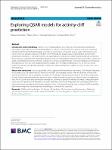Thông tin tài liệu

| Nhan đề : |
| Exploring QSAR models for activity-cliff prediction |
| Tác giả : |
| Markus, Dablander Thierry, Hanser Renaud, Lambiotte |
| Năm xuất bản : |
| 2023 |
| Nhà xuất bản : |
| Springer |
| Tóm tắt : |
| Pairs of similar compounds that only differ by a small structural modification but exhibit a large difference in their binding affinity for a given target are known as activity cliffs (ACs). It has been hypothesised that QSAR models struggle to predict ACs and that ACs thus form a major source of prediction error. However, the AC-prediction power of modern QSAR methods and its quantitative relationship to general QSAR-prediction performance is still underexplored. We systematically construct nine distinct QSAR models by combining three molecular representation methods (extended-connectivity fingerprints, physicochemical-descriptor vectors and graph isomorphism networks) with three regression techniques (random forests, k-nearest neighbours and multilayer perceptrons); we then use each resulting model to classify pairs of similar compounds as ACs or non-ACs and to predict the activities of individual molecules in three case studies: dopamine receptor D2, factor Xa, and SARS-CoV-2 main protease. |
| Mô tả: |
| CC BY |
| URI: |
| https://link.springer.com/article/10.1186/s13321-023-00708-w https://dlib.phenikaa-uni.edu.vn/handle/PNK/8224 |
| Bộ sưu tập |
| OER - Khoa học Tự nhiên |
XEM MÔ TẢ
146
XEM TOÀN VĂN
124
Danh sách tệp tin đính kèm:
